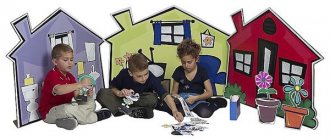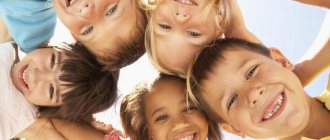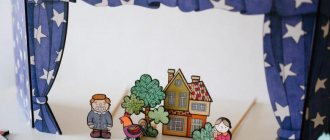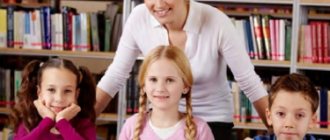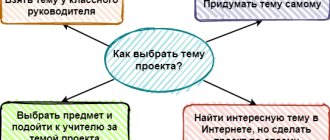Recreational and gaming “hour”.
Business game with teachers
"Motor activity in preschool educational institutions."
Target:
To clarify the knowledge of teachers on physical education and the development of motor activity in preschool educational institutions.
To intensify the mental activity of teachers, to develop their creative potential.
3. To acquaint teachers with innovative approaches to the physical education and health work of preschool educational institutions.
Systematize work to improve the forms of physical development and strengthen the health of children.
Materials and equipment: Illustrations with winter sports, crossword puzzle, tape recorder, recorded music, a selection of riddles, proverbs, sayings about sports and healthy lifestyle, multimedia system /projector, computer/. Handouts for participants in the business game: paper, newspaper, glue - pencil, pens, paper palms, reminders for teachers.
Progress of the game:
2 teams are formed from among the teachers of the preschool educational institution.
Educators are asked to choose red or blue stripes, i.e. Two teams of participants “Red” and “Blue” are formed.
Page one
"Team View".
Greeting, motto of teams without special training. Creativity, imagination, and ingenuity of the team are encouraged.
Page two.
Brain attack".
1. Name the main types of movement. ( Walking, running, jumping, crawling, climbing, throwing, catching, throwing, balance exercises, drill exercises, rhythmic gymnastics
.)
2. Name the drill exercises. ( Form in a column one at a time, in a line, change into columns in twos, threes. Opening in a column, in a line. Turns right to left, in a circle.)
3. What sports exercises do you know? ( Sledding, skiing, cycling, scootering, swimming
.)
4. What are we talking about? Short-term physical exercises promote a change in posture and nature of activity through physical activity . (physical education minutes)
5. Name the types of outdoor games. ( With running, with jumping, with climbing, crawling, with throwing, relay races, with elements of competition, folk games
.
6. It is important to follow all 5 stages of organizing a walk. Name them. Observation; Labor activity; Game activity; Individual work; Independent activity of children.
7. Give an example of outdoor games with running. ( “Traps”, “Mousetrap”, “We are funny guys”, “Homeless hare”, etc.
)
8. Give an example of outdoor games with jumping ( “Don’t stay on the floor”, “Fishing rod”, “From bump to bump”, “Classes”
.)
9. Give an example of outdoor games with throwing and catching. ( "Knock Down the Pin", "Hit the Hoop", "Hunters and Beasts"
.)
10. Name the forms of organizing motor activity in a preschool educational institution: (NOD for the physical development of children; Physical education and health work in the daily routine: morning exercises, outdoor games and physical exercises while walking, physical education minutes, physical education breaks, invigorating gymnastics after naps, hardening activities; Physical education corner in a group; Independent motor activity of children; Active leisure: physical education leisure, physical education holidays, health days).
11. Give an example of outdoor games with elements of competition. ( “Who is faster?”, “Whose team will score more goals?”, “Who is further”
.)
12. Give an example of folk games. ( “Burn, burn clearly!”, “Colors”, “By the bear in the forest”
.)
13. Name the sports games. ( Towns, elements of basketball, badminton, elements of football, hockey
.)
14. The main specific means of developing the physical qualities of children is ... (physical exercises) 15. Children's tourism is ... (walks and excursions) 16. What are we talking about? One of the means of health improvement and disease prevention. In children, the drowsy state disappears, a feeling of cheerfulness appears, an emotional upsurge sets in, and performance increases for the whole day - morning exercises.
17. This is a special joyful event for the child; it includes a variety of physical exercises and fun outdoor games, and includes movements previously learned in physical education classes (physical education leisure).
18. One of the main models for organizing the educational process of preschool children. Conditions - creation by teachers of a subject-developing educational environment that allows him to interact with peers or act individually (Independent activity of children).
19. Raise the mood and muscle tone of children with the help of contrasting air baths and physical exercises. Preserving and strengthening the health of children is the main goal..? (Invigorating gymnastics after sleep).
20. Serves to satisfy the preschooler’s need for movement, has a certain capacity corresponding to the age of the children . (Physical education corner).
Page three
"Information"
“Innovative approaches to the physical culture and health work of preschool educational institutions”
Preserving and strengthening the health of children is one of the main goals of any preschool educational institution. Every year, regardless of the annual tasks of the kindergarten, the preschool educational institution team pays attention to promoting the health and physical development of pupils and, in accordance with this, solves the problems of educational work.
Today I want to introduce you to innovative forms of physical education and health work with children from 1.5 to 7 years old.
Recreational and gaming “hour”.
“Hour” of motor creativity.
Dynamic "hour"
When introducing a new form of work - a recreational and gaming “hour”, one should take into account: the duration and intensity of physical activity, enrichment of the content and increase in the number of basic movements, individual characteristics in the volume and type of basic movements, a pronounced tendency to increase physical activity in the spring and summer period and its decrease in the autumn-winter period.
The main method of organizing such an “hour” for kids is the “game moment”. A recreational play “hour” for children is organized by the teacher after nap time. Its duration is for children from 1.5 to 2 years old - 8 minutes, from 2 to 3 years old - 8-10 minutes. The leading role in this form of work with children, naturally, belongs to the teacher. The organization of a recreational play hour involves a creative approach: the teacher can use a game, musical accompaniment, introduce additional game characters, use artistic expression, etc. But at the same time, a necessary condition remains taking into account the optimal physical activity and the emotional state of the children.
Another form of physical development of children from 3 to 7 years old can be an “hour” of motor creativity, which is organized in the gym. Children have the opportunity to choose the type of motor activity, sports equipment, partner, etc., in other words, children can feel like masters in the gym, master its space. The lack of external regulation allows them to evaluate their own actions as successful or unsuccessful. Moving independently in the hall helps relieve tension, indecisiveness, and stiffness, and develops confidence in one’s abilities, one’s safety and involvement in a common cause. For an hour of motor creativity, various types of movement are used: from outdoor games well known to children to joint activities with an adult or peers in an organized physical space. An hour of motor creativity is held in the afternoon in the gym under the direct supervision and with the active participation of the teacher. Parental participation is also encouraged. All this stimulates the activity of children (“we ourselves”), they begin to be interested in the skills of their comrades, help each other, exchange experiences, learn to act together, and confidently navigate the gym.
An additional hour of physical education activity can be introduced into the educational process - a dynamic “hour”, which is organized by the teacher during a daytime walk. Its duration is 18-20 minutes in groups of younger and middle age, 25-30 minutes in groups of senior preschool age. The content is determined according to the age of the children.
Instead of the classical organization of outdoor physical education, the emphasis is placed on the main type of children's activity - play.
The structure of the dynamic hour consists of two parts.
1. Healthy warm-up
prepares the body for physical activity. In a playful form, various types of walking, running, jumping, imitation movements, and exercises for the prevention of flat feet and posture are used.
2. Health and development training
a certain type of physical skills, development of physical qualities, formation of the ability to play outdoor games together.
The number of tasks in the first and second parts depends on the age of the children, weather conditions, physical activity and skills, location of the dynamic hour, etc. To increase interest in performing the given exercises, figurative play plots are used: “circus performers”, “young trackers”, “Indians”, “reindeer herders”, etc.
Depending on the time of year, location, weather conditions and assigned tasks, we can recommend several options for constructing a dynamic hour:
• game exercises, outdoor and sports games;
• game exercises, relay games;
• game exercises, round dance games.
In the coldest winter months (January-February), a dynamic hour is organized in the gym, subject to temperature control, in lightweight clothing. The dynamic hour is organized by the teacher in accordance with the long-term plan.
The system of health-saving physical education and recreational activities implemented by preschool educational institutions and control over the organization of innovative forms of physical activity will make it possible to diversify teaching activities and achieve better results in mastering the main types of movements. Without increasing the load, children can be offered motor activity rich in various possibilities, which will allow them to realize their main need - the need for movement.
Page four
Physical education kaleidoscope."
Teams are invited to demonstrate physical education exercises, finger exercises or outdoor play for all participants in the game.
Page five
"Crossword".
You need to solve a crossword puzzle by solving riddles about sports or sports equipment.
| As soon as I wake up in the morning, I’ll sit down, stand up and bend over - All the exercises in order! It will help you grow...(charging) There is ice on the field, a fence around, And a circle is drawn in the center. People are rushing across the field, as if looking for an exit or entrance. There are two entrances for the puck. And what is this? (gate) Two snub-nosed athletes run into the distance, ribbons behind them, fluttering as they run, Remain in the snow. (skis) I decided to become a strongman, I hurried to the strongman: - Tell me about this, How did you become a strongman? He smiled back: “Very simple.” For many years, every day, getting out of bed, I lift ... (dumbbells) I ride on it until the evening, But my lazy horse only carries me from the mountain. I myself walk up the hill and lead my horse by a rope. (sleigh) There is a lawn at our school, and there are goats and horses on it. We've been tumbling here for exactly forty-five minutes. At school there are horses and a lawn?! What a miracle, guess what! (gym) I don’t look like a horse. At least I have a saddle. There are knitting needles. I must admit, they are not suitable for knitting. Not an alarm clock, not a tram, But I’m calling so you know! (bicycle) This very necessary shield hangs above the stands. He will show every goal - You can see the score from all sides. (scoreboard) Who will catch up with me on the ice? We are running a race. And it’s not horses that carry me, But shiny ones... (skates) Horse, rope, log and bars, Rings next to them. I don’t dare to list a lot of shells. Gives us beauty and plasticity... (gymnastics) There is a stadium in the yard, but it is very slippery. To rush there like the wind, learn to skate. (skating rink) Small in stature, but brave, he galloped away from me. Even though he is always puffed up, there is never a dull moment with him. (ball) | Yesterday in the gym the girls showed us the class. It’s unlikely that any of the guys will do the same... (splits) There’s been a game in the yard since the morning, The kids are playing out. Shouts: “puck!”, “past!”, “hit!” - There is a game going on - ... (hockey). Small, remote, screams loudly, helps the referee, doesn’t know if he’s tired. (whistle). I look - the champion has a barbell weighing a quarter of a ton. I want to become the same, To protect my sister! Now I’ll be in the apartment lifting big...(weights). There is a blade in my hand, I use it to row through the water. So that our boat glides smoothly through the water. (oar) Two teams played football. We played, but didn't lose. “0:0” – that was the score of the match. Who will tell me the result? (draw) Whoever twists the sports equipment will soon be very slim. (hoop) We can swim here in winter too easily with you. Here they will teach us to dive. What should we call that place? (swimming pool) In this sport, the players are all dexterous and tall. They love to play with the ball and throw it into the hoop. The ball hits the floor loudly, So it’s...(basketball) You hit the goal - The ball won’t miss...(goalkeeper) |
Page six
"Live Pictures".
Teams receive illustrations of winter sports (hockey, figure skating, basketball, biathlon, rhythmic gymnastics, weightlifting, tennis, swimming, volleyball, football, parachuting, boxing, cycling, skiing). Teams take turns showing them using pantomime, and their opponents guess.
Page seven
"Meditation". Abbreviation (USSR, MDOU, FSB, CIS, Ministry of Emergency Situations, CIA, FZOZH, FGT, OOP, Federal State Educational Standard, Central Regional Hospital). Teachers are asked to decipher the abbreviations in accordance with the physical education and recreational topics. For example: USSR – the strongest and bravest guys, Ministry of Emergency Situations – we are sports champions, etc.
Page eight
"Practical skill"
The role of movements for the development of the psyche and intelligence is extremely great. From working muscles, impulses constantly enter the brain, stimulating the central nervous system and thereby promoting its development. The child’s physical activity not only contributes to the development of muscle strength as such, but also increases the body’s energy reserves.
